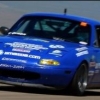Let's cut to the chase:
1. The shape of the dyno curves (forget the absolute numbers because they vary from dyno to dyno) show that the three generations of engines make power in very different ways. The 1.6 is top-biased,. the 01 is bottom-biased and the 99 is in-between. The dyno simply confirms our on-track impressions.
2. The dyno does not lie... but it doesn't tell the whole truth, either-- It can't measure the influence on acceleration of the 100 lb. weight difference between the 1.6 and the other two. Jim gave an example of a rough formula and I trust the committee took a hard look prior to the last rule change.
3. On track, the cars are close, but they still are apples and oranges. In the 1.6, tq starts very weak in the low rpm range and rises rapidly, while the curve in the other cars is much flatter. As a result, at tracks where the 1.6 is forced to pull out of a turn at low rpm's, or snatch a lower gear briefly, it is placed at a disadvantage. This disadvantage is magnified if the exit is uphill. If the revs are low enough, It's probable that the 100 lb weight advantage is not enough to offset the tq deficit. Grabbing a lower gear fixes this issue, but raises the spectre of missed shifts, and even a good shift takes time. On the other hand, the 1.6 is really strong on top and the old body style appears to have an aero advantage as well. There are tracks at which the 1.6 is the favorite (fast, flowing and not too hilly). Horses for courses.
4. I am not a technician, but I have observed that the 1.6 seems to require a lot of at-track tuning - even between sessions. If it's as finicky as it appears to be, I suspect a lot of 1.6 drivers are wheeling cars that are a bit off-song.
5. I have driven all three models and the 1.6 is the most fun to drive...but also the hardest. It has quick reflexes (some would say it's twitchy) and it doesn't handle curbs as well as the heavier cars. Also, because of its weakness at low revs, the driver is always trying to go 11/10's, which requires skill. I have won races in all three cars but it was easier to run consistent laps in the newer models.
6. Some of the suggested "fixes" such as increased compression and cams are worthy of consideration, but will meet resistance due to cost. Remember the shock hat fiasco? It would be a worthy goal to equalize weight. It may be appropriate (if possible) to give the 1.6 enough power to require a restrictor, assuming this would obviate the search for flow with the attendant cost.
All that said, the fact remains that these are very different cars and that it is impossible to precisely equalize them. There will always be debate about which is the better car, no matter what. The SCCA has done a good job, considering what they have to work with. Flame me if you wish, but I agree with Drago that further "equalization", as distinguished from favoritism, would have little effect at the front of the field.
I am reminded of how my father used to describe his philosophy of business negotiation: He would smile innocently, shrug his shoulders, show his palms and declare, "All I want is a fair advantage!" Think about it.




 Sign In
Sign In Create Account
Create Account







 Back to top
Back to top Report
Report
























